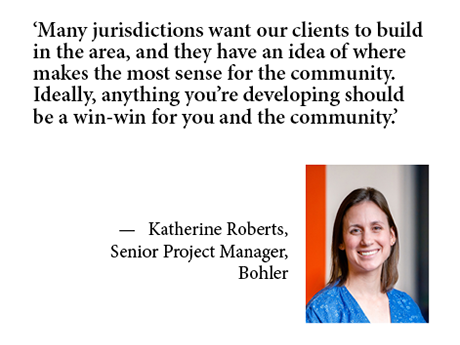As vacant sites become rare and cost-prohibitive, commercial real estate developers need to be creative when it comes to bringing a new project out of the ground. Unconventional development sites offer cost savings and location advantages, and in-depth due diligence and creativity on the part of developers can make for sites that can allow an elegant union of lower costs and strategy.
With limited room for delay, how can developers think critically about available sites and leverage existing conditions to their advantage? Katherine Roberts, senior project manager at Bohler’s Warrenton, VA office, and Gregory Roth, principal at Bohler’s Tampa office, offer their expert advice on threading this needle. Bohler specializes in land development, especially making development work when conventional sites aren’t an option.
Prioritizing Development Needs When Assessing Red Flags
Certain project factors can be red flags if time or cost are obstacles to a developer, including
- Environmental issues, including floodplains or resource protection areas (RPAs),
- High utility impact fees, especially for residential, although these fees may be mitigated with accommodations like affordable housing or age-restricted housing,
- Low availability of utilities,
- Unfavorable political climates, and
- Combative neighbors
These points of concern are usually knots that can be untangled if a developer has the time, money and appetite to move forward in spite of these interruptions, but each factor does bear watching.
“Developers should understand where their limits are and where they’re willing to negotiate. Ideally, anything you’re developing should be a win-win for you and the community,” says Roberts.

Roth backs that sentiment up, saying that it’s important to “Identify the needs for the site and prioritize them. Very few sites will be zoned properly for the intended use and density, in an A+ location, with perfect access and utilities suited to the property. Determine what can give, be clear about what is a must-have and understand that it may take more time in the permitting and entitlement process to accomplish what you are trying to achieve. Then put together the right team to tackle these hurdles.”
Due Diligence Helps Mitigate Risk
To understand a project’s limits, quality due diligence is key. “I like to say that there’s not really any bad news in the world of due diligence. You put in this investment upfront to see how good the fit is and how able you are to address issues like utility availability. You gauge county and community feedback. When you do that upfront, it helps to mitigate your risk later down the road after you’ve paid all the soft costs for having plans prepared,” says Roberts.
“By reviewing an ALTA survey, Phase I Environmental report, plus a due diligence report focused on zoning, stormwater, utilities and the permitting process, you are able to make a more informed decision on whether to continue forward,” says Roth.
Finding Sites that Work — Asking Partners for Support
While developers typically use brokers or their relationships in the industry to find the right site, success can often come from leveraging relationships with jurisdictional staff and with land development consulting companies.
Roberts says she has seen success from developers who — knowing that they are building a project the jurisdiction is excited about — ask the jurisdiction for help directly. Roberts says these clients ask questions like “Where do you recommend us developing?” and “What property owners do you know that might be able to help?”
“Many jurisdictions want our clients to build in the area, and they have an idea of where makes the most sense for the community,” says Roberts. Willingness from the developer to be flexible on prototypes and design standards in order to meet the jurisdiction’s desires goes a long way toward success, especially if options are presented upfront and early to the jurisdiction, avoiding the need for costly changes later.
If clients are having a difficult time making a site work (because of cost, time, political climate, etc.), Roberts encourages developers to partner with other developers in the area who are already proposing sites nearby. A working relationship between two such developers can relieve both parties of some costs. “Working together to get something approved more quickly, reduce the costs across the board and meet the same goal can mean a client can tackle a challenging site without taking on too great a burden alone.”
Working with an experienced, locally based land development consulting company can make the process of connecting with partners even easier, Roberts explains. In her due diligence, she makes a point to find out about nearby projects and make connections. “A lot of our success really does come from our close relationships with jurisdictional staff, because they know best what is happening in the area.”
Roberts also encourages clients to lean on their partners: land development consultants, site civil engineers, geotechnical experts and land use attorneys may all have insight into opportunities within the area. “They may have seen projects that didn’t move forward but were still good sites or that still had potential for development. Bohler has a lot of experience on sites and has investigated many vacant spaces. We have history on what might work in a given location and what was important to decision-makers in those jurisdictions. And having worked with all of the big players in the area — consultants, attorneys, architects, etc. — helps us do our job better and be able to come up with more creative solutions together.”
Creativity and Flexibility
Developers have a wealth of options when it comes to creating spaces and offering choices that will fit the community and please the jurisdiction. Offering flexible spaces that allow enjoyment and value on multiple levels benefits the community while considering the area’s long-term needs.
For example, “If retail isn’t a good fit as part of a residential development, offering a space tenants can lease for the short term or opening the space up to the community for a farmers’ market or a multi-use space can provide tenants and the community with a highly functional area. These spaces function more like an amenity,” explains Roberts.
Likewise, resident parking that can be rented by the public in busy areas or at busy times allows plasticity in planned spaces.
Planning to complement your surroundings can make for a better development fit and a practical approach to challenges. “In Florida, and in the south in general, a lot of stormwater requirements are quite rigorous. Innovations like underground stormwater maximize the developable area,” explains Roth. “Swaps with adjacent parcels to gain better site access or increase usable land area, plus off-site wetland mitigation or floodplain compensation are also options.”
Landscaping around parking lots can provide additional green space or amenities to the community, plus provide benefits like noise reduction and green infrastructure stormwater solutions.
RPAs, where developers cannot build, offer further opportunities to make the best use of every space. “In those areas, you can often plant in them, or put a shared-use path or similar features,” outlines Roberts. “Jurisdictions often want to see RPAs cleaned up, replanted and to have invasive species of plants taken out. In some jurisdictions, if you’re able to replant and get invasive species out, you can call it a ‘new forested area.’ In Virginia, that’s counted toward your stormwater management quality credits and reduces the cost of your stormwater management systems on-site. If you have the space, it’s a really good opportunity to save costs and give the community something valuable.”
Bohler is a content partner of REBusinessOnline. For more articles from and news about Bohler, click here.


